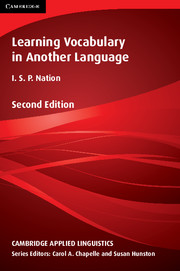Book contents
- Frontmatter
- Contents
- Series editors' preface
- Acknowledgements
- Introduction
- 1 The goals of vocabulary learning
- 2 Knowing a word
- 3 Teaching and explaining vocabulary
- 4 Vocabulary and listening and speaking
- 5 Vocabulary and reading and writing
- 6 Specialised uses of vocabulary
- 7 Vocabulary-learning strategies
- 8 Learning words from context
- 9 Word parts
- 10 Using dictionaries
- 11 Deliberate learning from word cards
- 12 Finding and learning multiword units
- 13 Testing vocabulary knowledge and use
- 14 Designing the vocabulary component of a language course
- Appendices
- Subject index
- Author index
7 - Vocabulary-learning strategies
Published online by Cambridge University Press: 15 February 2018
- Frontmatter
- Contents
- Series editors' preface
- Acknowledgements
- Introduction
- 1 The goals of vocabulary learning
- 2 Knowing a word
- 3 Teaching and explaining vocabulary
- 4 Vocabulary and listening and speaking
- 5 Vocabulary and reading and writing
- 6 Specialised uses of vocabulary
- 7 Vocabulary-learning strategies
- 8 Learning words from context
- 9 Word parts
- 10 Using dictionaries
- 11 Deliberate learning from word cards
- 12 Finding and learning multiword units
- 13 Testing vocabulary knowledge and use
- 14 Designing the vocabulary component of a language course
- Appendices
- Subject index
- Author index
Summary
Vocabulary-learning strategies are a part of language-learning strategies which in turn are a part of general learning strategies. In general, the findings of research on vocabulary-learning strategies agree with studies of more general language-learning strategy use. Schmitt (1997) provides a very useful overview of the rise in importance of strategy use in second language learning, noting that it grew out of an interest in learners' active role in the learning process.
It is not easy to arrive at a definition of what a strategy is, but to deserve attention from a teacher, a strategy would need to:
involve choice, that is, there are several strategies to choose from and one choice could be not to use the strategy;
be complex, that is, there are several steps to learn;
require knowledge and benefit from training; and
increase the efficiency and effectiveness of vocabulary learning and vocabulary use.
There are numerous strategies which have these features. Learners not only need to know about these strategies, but need to have skill in using them.
What vocabulary learning strategies are there?
Gu (2003a) provides an excellent review of research on a wide range of strategies for vocabulary learning, making the point that ‘the choice, use, and effectiveness of vocabulary learning strategies depend on the task, the learner, and the learning context’ (p. 1). Gu's review covers the task-dependent strategies of learning from context, dictionary use, vocabulary notetaking, rote rehearsal, encoding (the processing), word formation, semantic networks and vocabulary in use.
- Type
- Chapter
- Information
- Learning Vocabulary in Another Language , pp. 326 - 347Publisher: Cambridge University PressPrint publication year: 2013

